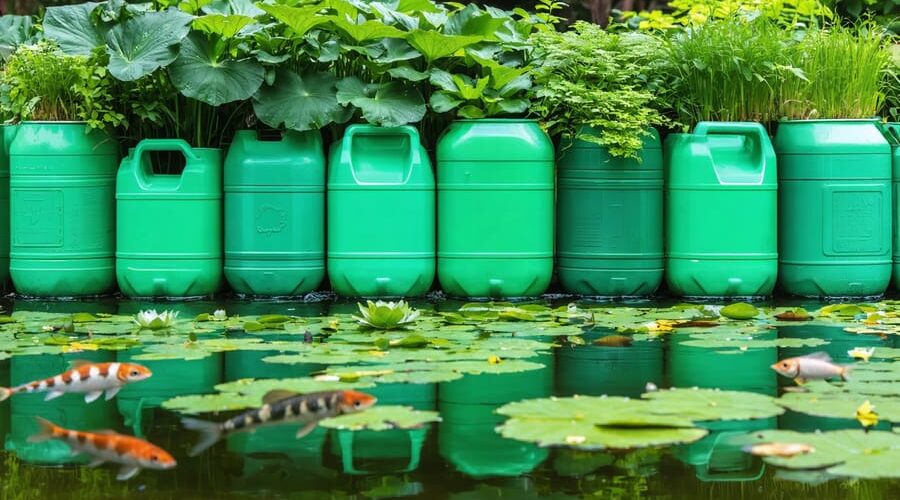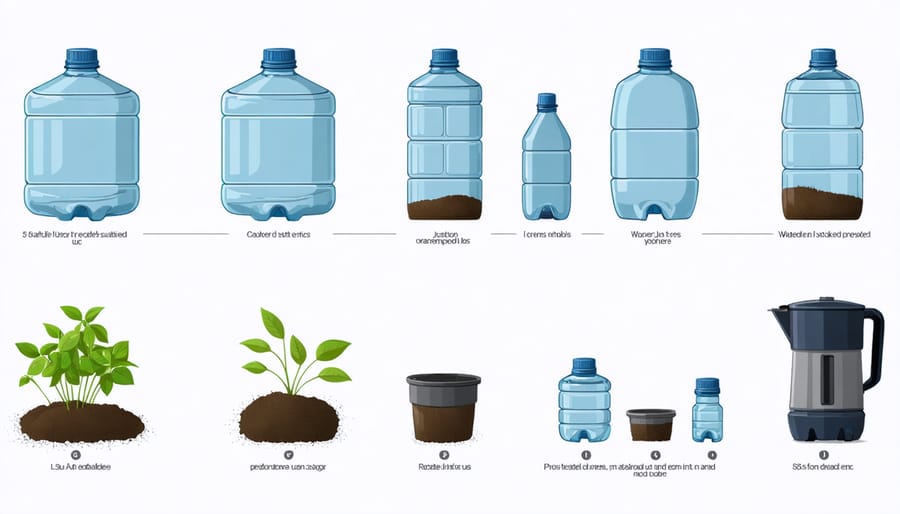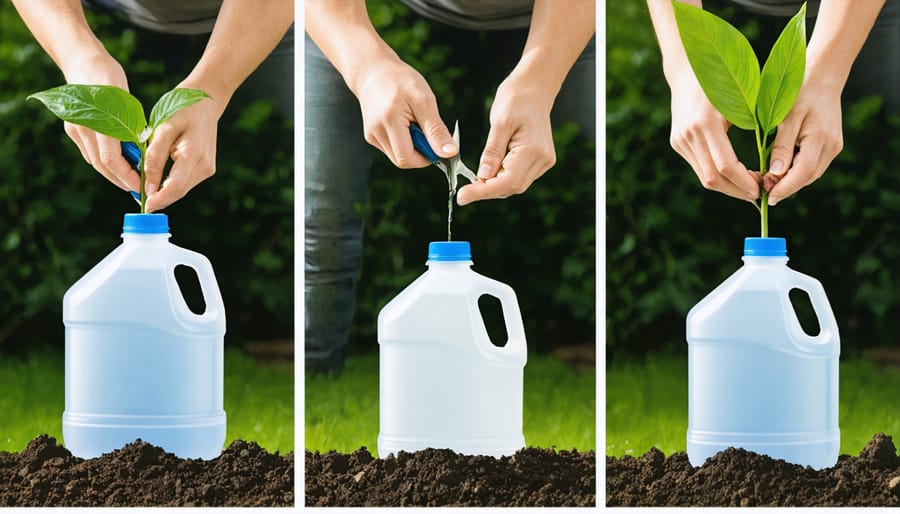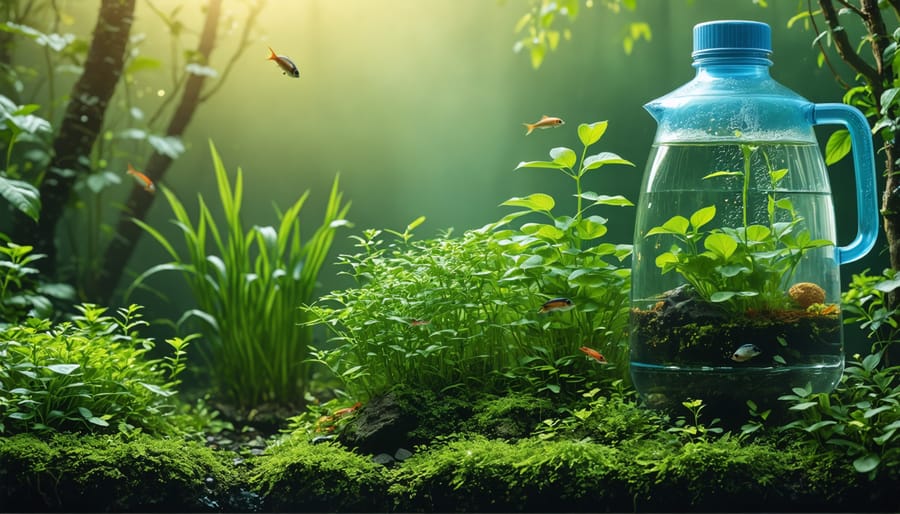
Transform 5-Gallon Jugs Into Beautiful Community Water Gardens
Transform ordinary 5-gallon water jugs into stunning aquatic gardens that bring life and tranquility to any outdoor space. These versatile containers, readily available and perfect for community water garden projects, offer an affordable gateway into water gardening. By repurposing these containers, you’ll create sustainable mini-ecosystems that support aquatic plants, attract beneficial wildlife, and add visual interest to your landscape. Whether you’re a seasoned gardener or just starting out, these easy-to-maintain water gardens provide endless opportunities for creativity while promoting environmental consciousness. Join the growing movement of DIY enthusiasts who are discovering how these simple containers can become thriving aquatic sanctuaries, perfect for patios, balconies, or community gardens.
Getting Started: Materials and Planning
Gathering Your Supplies
Before starting your 5-gallon water jug garden, gather these essential supplies:
Main Components:
– Clean 5-gallon water jug
– Sharp utility knife or scissors
– Aquatic potting soil
– Small water pump (100-200 GPH)
– Aquatic plants (2-3 varieties)
– Decorative rocks or pebbles
– Black spray paint (optional)
Tools and Accessories:
– Drill with 1/2-inch bit
– Measuring tape
– Marker
– Sandpaper
– Garden gloves
– Small fish net
– Water testing kit
– Liquid fertilizer for aquatic plants
Safety Equipment:
– Safety goggles
– Work gloves
– Dust mask
Most of these items can be found at your local garden center or hardware store. For the water jug, you can either purchase a new one or repurpose a used container – just ensure it’s thoroughly cleaned and free from any chemical residue. Remember to choose compact plants that won’t outgrow your container too quickly.

Planning Your Layout
Before diving into construction, take time to consider basic water garden design principles for your 5-gallon jug garden. Start by choosing a location that receives 4-6 hours of sunlight daily, while avoiding areas with extreme afternoon heat. Consider creating visual interest by arranging multiple jugs at different heights – perhaps using sturdy crates or wooden blocks as risers.
For single-jug setups, center your container in the chosen space, ensuring easy access for maintenance. If you’re working with multiple jugs, try clustering them in odd numbers (3 or 5) for aesthetic appeal. You might arrange them in a triangular pattern or create a cascading effect where water flows from one jug to another.
Remember to leave enough space between containers for easy plant maintenance and to prevent overcrowding as your water garden grows. Keep taller plants towards the back or center, with floating plants distributed evenly across the water surface.
Creating Your Water Garden System
Preparing the Jugs
Before transforming your 5-gallon water jugs into beautiful garden features, proper preparation is essential. Start by thoroughly cleaning each jug with a mixture of warm water and mild dish soap. Rinse multiple times to remove any soap residue, and let them dry completely in the sun.
Next, carefully remove the labels from your jugs. You can make this task easier by soaking the labels in warm water or using a hairdryer to heat the adhesive. For stubborn residue, try using white vinegar or a citrus-based adhesive remover.
Now comes the creative part! Using a sharp utility knife or heavy-duty scissors, cut your jug according to your garden design. For vertical gardens, cut one side panel, leaving the bottom intact to create a “pocket.” For horizontal planters, cut along the length of the jug, creating two equal halves. Don’t forget to drill several drainage holes in the bottom – this is crucial for plant health!
Sand down any sharp edges with medium-grit sandpaper to prevent cuts and ensure safety. If you’re planning to paint your jugs, lightly scuff the entire surface to help the paint adhere better. For outdoor use, consider using UV-resistant spray paint to prevent degradation from sun exposure.
Remember to save the caps – they can be useful for future projects or as drainage control mechanisms when needed.

Setting Up the Water System
Setting up the water system in your 5-gallon jug garden is crucial for healthy plant growth. Start by drilling several small drainage holes (about 1/4 inch) in the bottom of your jug using a power drill. Space these holes about 2 inches apart to ensure proper water flow. If you’re creating a self-watering system, you’ll need two jugs – one for the plants and one as a water reservoir.
For the reservoir jug, cut off the top third and invert it to create a funnel shape. This will help direct water to your plants efficiently. Connect the two sections using strong waterproof tape or by creating notches that lock together. To create a wicking system, cut a piece of cotton rope or thick fabric about 12 inches long. Thread this through one of the drainage holes, leaving about 4 inches hanging into the reservoir below.
Fill the bottom container with water and add a few drops of liquid fertilizer if desired. The wicking material will draw water up to your plants as needed, creating a self-sustaining system. For added stability, consider placing small rocks or gravel in the bottom of the planting container before adding your growing medium.
Remember to monitor the water level in your reservoir and refill it when it gets low. In hot weather, you might need to check it more frequently. This system helps conserve water while keeping your plants consistently hydrated.
Planting and Stocking Your Garden
Choosing the Right Plants
When selecting plants for your 5-gallon water jug garden, focus on species that thrive in water or moisture-rich environments. Water lettuce and duckweed are excellent floating plants that help maintain water quality while adding visual interest. These plants also provide natural shade, which helps prevent algae growth.
For the main focal points, consider water lilies or lotus plants. Choose dwarf varieties that won’t overwhelm your container’s size. Water lilies come in various colors and will create stunning blooms throughout the growing season. Place these larger plants in the center or back of your container for the best visual impact.
Around the edges, marsh marigolds and water iris make fantastic additions. These marginal plants prefer having their roots in shallow water while their foliage grows above the surface. For vertical interest, try including rushes or sedges, which add height and texture to your arrangement.
Don’t forget about oxygenating plants like hornwort or anacharis. These underwater plants are essential for maintaining healthy water conditions and supporting any aquatic life you might add later. Place them near the bottom of your container, where they can effectively filter the water.
Remember to leave enough space between plants for growth and proper water circulation. Start with just a few species and add more as you gain confidence in maintaining your water garden.
Adding Aquatic Life
When it comes to adding life to your water jug garden, you have several exciting options that can create a thriving aquatic ecosystem setup. Small fish like guppies, bettas, or white cloud mountain minnows are excellent choices, as they adapt well to confined spaces. For best results, stick to 2-3 small fish per jug to maintain proper oxygen levels and prevent overcrowding.
Consider adding aquatic snails like ramshorn or nerite snails – they’re natural cleaners that help keep algae under control. Floating plants such as duckweed or water lettuce provide shelter for your fish while helping maintain water quality.
Before introducing any aquatic life, let your water jug garden cycle for at least a week to establish beneficial bacteria. Make sure to acclimate your new fish slowly by floating their bag in the water for 15-20 minutes before release. Monitor water parameters regularly using basic test strips to ensure a healthy environment for your aquatic friends.
Remember, fish can be sensitive to temperature changes, so position your water jug garden where it won’t experience extreme fluctuations throughout the day.

Maintaining Your Community Water Garden
Regular Maintenance Tasks
To keep your 5-gallon water jug garden thriving, establish a simple daily and weekly maintenance routine. Each morning, check the water level and top it up if needed, especially during hot weather when evaporation is higher. Monitor your plants daily for any signs of yellowing leaves, pest problems, or unusual growth patterns.
Weekly tasks include testing the water quality with basic test strips, cleaning any debris from the water surface, and trimming dead or yellowing leaves. If you notice algae starting to form, reduce the amount of direct sunlight or add a few floating plants to help maintain balance.
Every two weeks, replace about 25% of the water to keep nutrients balanced. While doing this, gently clean the sides of the jug with a soft sponge to prevent buildup. Remember to check that your plant supports are secure and adjust them if needed as your plants grow.
Fertilize your plants monthly using a water-soluble fertilizer specifically designed for water gardens, following the package instructions carefully to avoid over-fertilizing.
Troubleshooting Common Issues
Having trouble with your 5-gallon water jug garden? Here are solutions to common issues you might encounter. If your plants are yellowing, it’s likely due to insufficient nutrients – try adding a balanced liquid fertilizer every two weeks. For algae buildup, reduce direct sunlight exposure and add floating plants like duckweed to compete with algae for nutrients.
Dealing with mosquito larvae? Add a few drops of food-grade nonionic surfactant or introduce small fish like guppies. If your water level drops too quickly, check for leaks around the spout area and seal with aquarium-safe silicone. Brown or wilting plants usually indicate root rot – trim affected areas and ensure proper water circulation.
For unstable jugs that tip over, create a wider base using a planter saucer or embed the bottom partially in gravel. If plants aren’t thriving, verify that you’ve chosen species suitable for water gardens and that they’re getting adequate light without overheating.
Creating a 5-gallon water jug garden is more than just a fun DIY project – it’s a sustainable way to bring beauty and life to any space while building community connections. The low cost, accessibility of materials, and ease of maintenance make it perfect for both individual and group projects. By repurposing water jugs, you’re not only creating stunning water features but also contributing to environmental conservation. Whether you start small with a single container or collaborate with neighbors to create a network of water gardens, the rewards are endless. From the soothing sounds of trickling water to the joy of watching aquatic plants thrive, these miniature ecosystems bring peace and natural beauty to any setting. So gather your supplies, reach out to your community, and start transforming those empty water jugs into vibrant garden features that everyone can enjoy!
